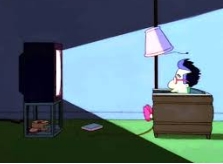Ed's AV
Handbook
Batting Practice for the AV Professional
and primer for the novice
Chapter
4 Page 8
Video Reproduction
Brightness,
Luminance, Color
Brightness
Brightness is to video as subjective loudness is to audio. Much as the ear to sound, the eye is not equally sensitive to the entire bandwidth of light.The human eye is very sensitive to the wavelength of green light, less sensitive to red light, and even less to blue light.
Luminance
Luminance is the objective directional intensity of
light. Luminance is to video as the objective decibel is
to sound. And as the audio decibel, the lumen, foot-lambert, and nit are the measure units of luminance. The choice of measurement depends on the type of display used.
The Peak Lumen
& The Projector
The lumen is to luminance as the decibel is to
sound. The peak lumen is a measure of video
projector luminance. It measures a projected centered test pattern of a white block filling 10% to 20% on the projection screen. The balance of the screen remains black.
The
LED Lumen
The term LED lumen has been introduced to laser projector spec sheets.
The term LED lumen has been introduced to laser projector spec sheets.
The Laser diode light is LED
based. LED light produce a narrow light beam pattern
compared to the UHE-lamp.
The
LED lumen measurement accounts for this
regarding room lighting.
However, this does not affect
peak lumen projector measurement.
ANSI Lumen
& The Projector
The peak lumen is limited to a small angle of projector
radiation. Because of this limitation, the American
National Standards Institute offers a more stringent useful
measurement, the ANSI Lumen. The ANSI lumen
specification averages several measurements taken at different
positions on the projection screen. As a reference, a
projector that produces 1200 peak lumen may only measure 200
ANSI lumen. This measure is similar to speaker
dispersion pattern. Foot Lambert
& The Projector & Screen
Home theater projector-big-screen enthusiasts are more
concerned about the level of light at the viewer than at the
screen. Projector luminance is useful. But
reflected luminance decreases as screen square footage
increases. Luminance also decreases as the distance
between the projector, screen, and viewer increase. The
ANSI lumen does not sufficiently facilitate the home theater
enthusiast's objective.The Foot-Lambert (ft-L) offers a more useful practical measurement. The Foot-Lambert is a factor of projector lumens, screen gain, diagonal screen dimension, screen width, screen height, and aspect ratio. ProjectorScreen.com offers a website calculator. The calculator produces a reasonable estimate of the projection system's luminance in foot-Lamberts.
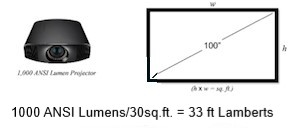
As a reference, the Society
of Motion Picture and Television Engineers (SMPTE)
recommends a level of 12 to 22 Foot-Lamberts with a goal
of 16 ft-L in a dark room. If a low level of ambient
light is unavoidable, then 30 to 50 ft-L is the
recommended goal.
The Nit
& TV Screen
Select this LINK for additional ANSI Lumen to Nit
information.

The ANSI static contrast ratio uses a standardized
checkerboard test pattern of black and white rectangles.
The ANSI standard simultaneously measures the difference
between the darkest black and brightest white displayed side
by side on a projection screen.
It's a Matter of Scale, Grayscale.
Accurate luminance reproduction precisely ascends, scales, from absolute black to specified white light. An accurate scale, or grayscale, generates accurate color much as accurate audio frequency response generates accurate musical timbre.
Contrast Ratio
Contrast ratio is the difference between the brightest and darkest screen image. There are two types of contrast ratio measurement -- dynamic and ANSI static. The contrast difference establishes the dynamic range of luminance plus shades of color.Dynamic Contrast
The dynamic contrast ratio is the most quoted by manufacturers, e-zines, and magazines. Dynamic contrast refers to the deepest black versus the brightness white that a television, studio monitor, projector/screen can display, but not at the same time. Dynamic contrast is an all-on versus all-off test. This simple test can generate impressive numbers such as 20,000:1 or higher. 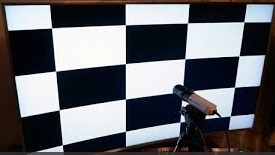
ANSI Static Contrast Ratio
The ANSI static contrast ratio uses a standardized
checkerboard test pattern of black and white rectangles.
The ANSI standard simultaneously measures the difference
between the darkest black and brightest white displayed side
by side on a projection screen. A Contrasting Story
A friend shared the following story to put contrast measurement into a real-world frame of reference.He had attended an Imaging Science Seminar. During the presentation, he observed that a colleague of the lecturer had entered the rear of the room. The lecturer acknowledged his colleague with a nod as he continued to speak until he finished his point.
The lecturer then looked to his colleague and asked, "How did you do?" His colleague answered, "300 to 1". The lecturer responded, "No way!'. His colleague insisted, "300 to 1". Again, the lecturer responded No way. He then paused and said, "Not unless ... you turned off the exit lights". Yes, his colleague admitted with a grin. 300 to 1 was his contrast result.
The lecturer then turned to the seminar audience to explain their exchange. His colleague had just completed the calibration of a commercial digital theater projector. 300 to 1 referred to the ANSI static contrast ratio he had achieved with the exit lights off. The lecturer then said, "Given what you just heard, you should be asking, where do contrast ratios exceeding more than 10000 to 1 come from?"
He explained that many projector manufacturers begin with a measurement of light in an absolutely-dark room. Well, there isn't any light. Then they turn their projector on with the lamp gain set to its highest adjustment. Then they measure the light at the projection screen. This non-ANSI difference is their contrast ratio specification. The seminar attendees then responded with a chorus of groans. The point, be skeptical of contrast ratio claims.
Color Temperature
Have you ever heard the expression 'red hot' or 'white-hot'? Both have their origin in blacksmithing and welding. As a welding torch heats a piece of iron, it changes from black to red to white, to blue. This effect is the basis for the concept of color temperature in degrees Kelvin. 6500° Kelvin is the video color temperature standard of white light. Film uses a white standard of 5500° Kelvin.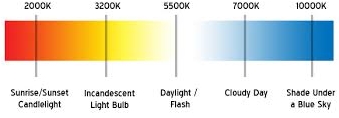
C.I.E. Color Chart
The C.I.E. is the international
organization of color specification. The range of
visible color, or color space, is the x, y, z, points of the
C.I.E. Color Chart.
It resembles a three dimensional cone -- narrow at the top -- wide at the base.
It resembles a three dimensional cone -- narrow at the top -- wide at the base.
The chart's x and y points stake
the color points of red, green, and blue. All color is
more or less bounded within the area of the red, green, blue
points.
The chart's z-axis, marks the
amplitude, or luminance, of the color.
Some refer to the z-axis as
brightness. But that's not correct. The z-axis is
luminance, the objective measurement of light.
Brightness is the subjective-response of the eye.
The
D65 point, near the top, equals 6500° Kelvin, the color
white. The z-axis lowest point equals black.
Points from black to D65 track the gray-scale
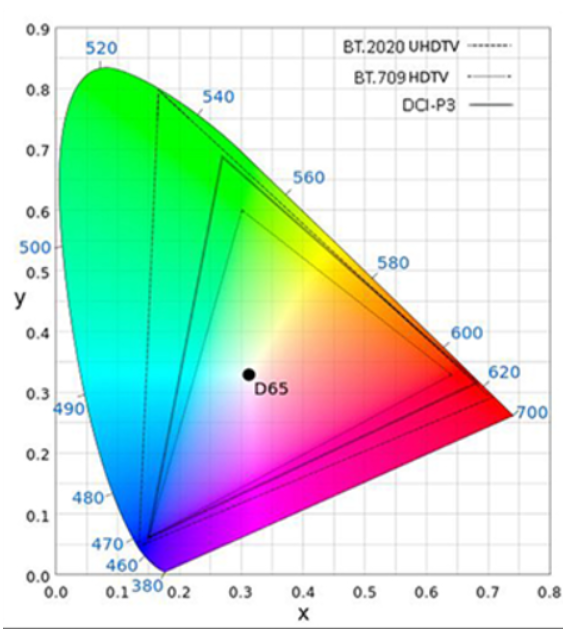
Color Space
Color space is the total specified space of human vision outlined in the C.I.E. color chart.Color Gamut
Color gamut is the area within the color space allocated to a video specification such as HDTV.HDTV = 35% of the color space. UltraHD = 76% of the color space.
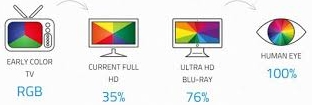
Color Volume
Color volume measures the percent of the color gamut achieved by the video display.x.v. Color
x.v.Color is the HDTV color gamut
specification.
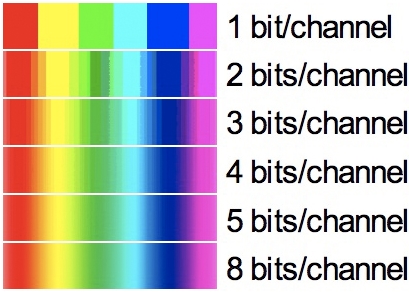
DCI P3
DCI P3 is the Digital Cinema Initiative (movie theater) color gamut specification.Bit Depth or Color Depth
Color depth is the number of computer bits allocated to create video color.
Deep Color
Deep Color defines HDTV 8 bit per channel color that produces more than 1.67 million shades of color.
WCG
WCG (Wide Color Gamut) describes 10-bit or more color depth. For example, HDR10+ offers 10-bit color, Dolby Vision offers 10-bit color with a planned potential for 12-bit color. The increase from 10-bit to 12-bit will extend the color palette from one billion to four billion colors.Gamma
Gamma is a fixed grayscale
correction to accommodate the subjective response
(brightness) of the human eye.
If you're a seasoned AV pro, gamma is similar to the Fletcher-Munson audio loudness compensation curve.
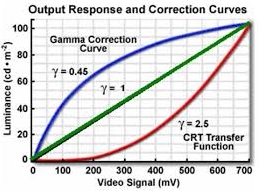
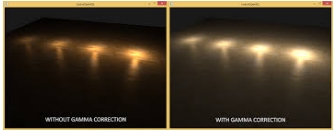
If you're a seasoned AV pro, gamma is similar to the Fletcher-Munson audio loudness compensation curve.


EOTF
Electro-optical-transfer-function
is a dynamic grayscale correction, not fixed, to accommodate
the subjective response of the human eye.
EOTF continually optimizes night/dark and day/bright images on a frame-by-frame basis
EOTF continually optimizes night/dark and day/bright images on a frame-by-frame basis
Site Menu
Home
Table of
Contents
Handbook Chapters
1 AV
Terms
2 AV Physics
3 Sound Reproduction
4 Video Reproduction
5 The AV System Sequence
6 The Room, Speaker, & TV
7 Acoustical Strategy - Small Room
8 Home Theater by Design
9 AV Sales Training
10 AV Business & Marketing
Contact
About

